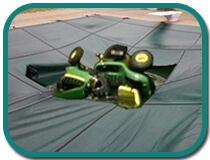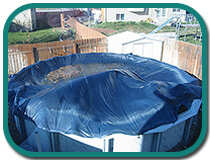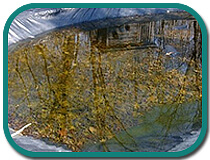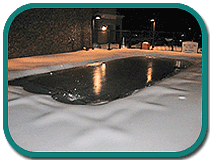FREE Standard Shipping On All Orders $100 or More!*
The 7 Enemies of a Winter Pool Cover
Your winter pool cover labors to protect your pool from sun, debris and in the case of solid covers, from contaminants washed into the pool from rain and snowfall.
Pool covers befall all sorts of maladies, some common, some odd. Here's 7 enemies of your pool cover, and how you can thwart them.
Trees: Number 1 enemy of the state - are those beautiful trees surrounding the pool. As the leaves drop, you can more easily spot broken or dead branches. This is the time to do some fall pruning of trees near the pool.
Even tree branches that are a good distance from the pool can be picked up by a strong wind, and thrown down to your pool cover. If the angle is right, or the branch heavy enough, pool cover damage is the result. Trees are the number one cause of pool cover failure.
Vehicles: Not just cars, but minibikes, ATV's, bicycles, lawnmowers and farm equipment. If your pool is near a busy street, or if it could be possible for a car to crash through the fence and into the pool, consider installing some bollard poles or large landscape boulders to stop or deflect oncoming cars.

It's more common than you may think, and it's often not cars crashing through the fence, but runaway lawn equipment or teenage stunts gone wrong. In most cases, the pool cover will lose any battles with vehicle enemies and the drivers are often in danger.
Animals: Wild animals large enough to damage a pool cover include bears and deer, and depending where you live, wild pigs, alligators, elk and moose. Farm animals that are allowed to get too close to a covered pool are also in danger of falling on the cover. Even a safety cover can be severely damaged by heavy hooves. Large dogs may not damage a safety cover, but floating pool covers can easily be ripped from sharp claws, and are not safe for pets to be around.
A sturdy pool fence, 5 or 6 feet tall is usually enough to keep out most four legged animals. Keeping a clean pool cover can also help. This time of year there can be so many leaves on top of a pool cover that it completely hides the pool cover. Spooked animals try to run across the cover, and don't usually get far.
Wind: High winds can get up under solid covers, and pull them right off the pool, sometimes ripping them in the process. Some people like to leave a little water on the cover to help hold down solid pool covers.

Wall bags are small vinyl bags you can fill up with water and lay on top of an aboveground cover. Winter Cover Seal and Cover Clips are two more wind-stopping products for use with above ground pool covers.
Wind can also hurl items on your pool cover. Not only tree branches, but door and window screens, pool poles - just about anything not nailed down could become a pool cover killing projectile during winter storms.
Water: Too much water on top of a solid pool cover, and it will weaken the seams, and make small holes larger. It can also pull the cover towards the pool, and in some cases the cover can fall into the pool. Messy. Use a cover pump placed on an upside-down Frisbee, so that if there are any holes in the cover, you won't end up pumping out pool water, through holes in the cover.

If water on top of a cover is important, the level of water under the cover is crucial. If a pool begins to leak water during winter, solid covers can fall in, and safety covers won't have the support needed. Safety cover manufacturers warn to never let the water fall more than 18" below the cover. Without the water to support it, safety cover springs and straps can bend and break.
The water level can also become too high for safety covers that allow rain and snow to melt through. At some point during winter or spring, if the water level begins to touch the underside of the cover, use a cover pump to lower the water level in the pool.
Fire: Not surprisingly, sparks and flames can melt holes in any type of pool cover. This enemy of your pool cover can attack from an outdoor fire pit or bonfire too close to the pool's edge.
Planning fireworks on New Year's Eve? I have seen safety covers destroyed from large firework displays. Nearby forest fires? It may be best to remove the cover until the danger is past.
Ice: In most cases, the ice that forms on a pool cover during winter won't damage the pool cover. This enemy needs a little help - from the pool owner. Never try to shovel, scrape or God forbid, melt the ice from your pool cover.

Safety covers especially, look as if they are going to break, when they are stuck in the ice of the pool and weighed down heavily with snow and ice. But don't worry, it will melt eventually, and your safety cover will spring back up to it's former trampoline appearance.
Keep solid pool covers pumped off as dry as possible during deep winter, and you'll risk less damage from sharp edges of a large ice sheet on top of the pool cover. For snow storms, your cover pump won't pump snow, but after the thaw, pump it off quickly, before the next freeze.
Enemies of your pool cover - they can be managed and mitigated. Take care with these 7 enemies and you and your pool cover can weather many winters together.